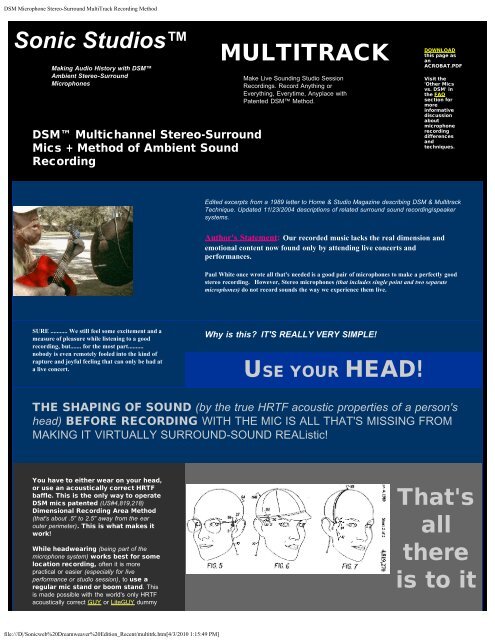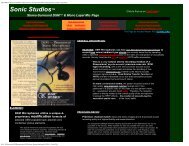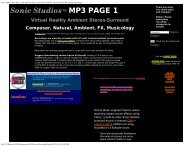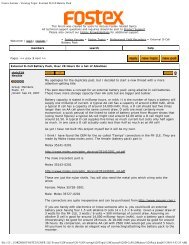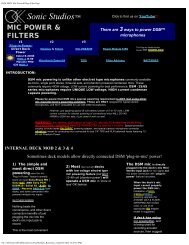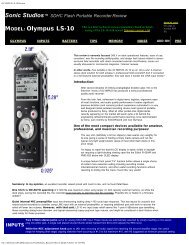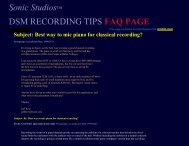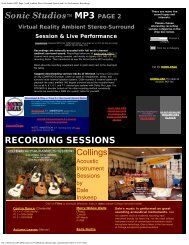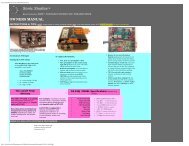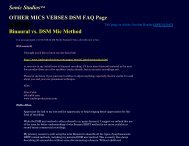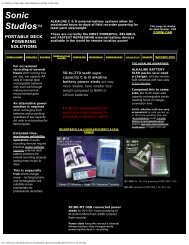DSM Microphone Stereo-Surround MultiTrack ... - Sonic Studios
DSM Microphone Stereo-Surround MultiTrack ... - Sonic Studios
DSM Microphone Stereo-Surround MultiTrack ... - Sonic Studios
You also want an ePaper? Increase the reach of your titles
YUMPU automatically turns print PDFs into web optimized ePapers that Google loves.
<strong>DSM</strong> <strong>Microphone</strong> <strong>Stereo</strong>-<strong>Surround</strong> <strong>MultiTrack</strong> Recording Method<br />
<strong>Sonic</strong> <strong>Studios</strong><br />
Making Audio History with <strong>DSM</strong><br />
Ambient <strong>Stereo</strong>-<strong>Surround</strong><br />
<strong>Microphone</strong>s<br />
<strong>DSM</strong> Multichannel <strong>Stereo</strong>-<strong>Surround</strong><br />
Mics + Method of Ambient Sound<br />
Recording<br />
MULTITRACK<br />
Make Live Sounding Studio Session<br />
Recordings. Record Anything or<br />
Everything, Everytime, Anyplace with<br />
Patented <strong>DSM</strong> Method.<br />
DOWNLOAD<br />
this page as<br />
an<br />
ACROBAT.PDF<br />
Visit the<br />
'Other Mics<br />
vs. <strong>DSM</strong>' in<br />
the FAQ<br />
section for<br />
more<br />
informative<br />
discussion<br />
about<br />
microphone<br />
recording<br />
differences<br />
and<br />
techniques.<br />
Edited excerpts from a 1989 letter to Home & Studio Magazine describing <strong>DSM</strong> & Multitrack<br />
Technique. Updated 11/23/2004 descriptions of related surround sound recording/speaker<br />
systems.<br />
Author's Statement: Our recorded music lacks the real dimension and<br />
emotional content now found only by attending live concerts and<br />
performances.<br />
Paul White once wrote all that's needed is a good pair of microphones to make a perfectly good<br />
stereo recording. However, <strong>Stereo</strong> microphones (that includes single point and two separate<br />
microphones) do not record sounds the way we experience them live.<br />
SURE ........... We still feel some excitement and a<br />
measure of pleasure while listening to a good<br />
recording, but....... for the most part..........<br />
nobody is even remotely fooled into the kind of<br />
rapture and joyful feeling that can only be had at<br />
a live concert.<br />
Why is this? IT'S REALLY VERY SIMPLE!<br />
USE YOUR HEAD!<br />
THE SHAPING OF SOUND (by the true HRTF acoustic properties of a person's<br />
head) BEFORE RECORDING WITH THE MIC IS ALL THAT'S MISSING FROM<br />
MAKING IT VIRTUALLY SURROUND-SOUND REAListic!<br />
You have to either wear on your head,<br />
or use an acoustically correct HRTF<br />
baffle. This is the only way to operate<br />
<strong>DSM</strong> mics patented (US#4,819,218)<br />
Dimensional Recording Area Method<br />
(that's about .5" to 2.5" away from the ear<br />
outer perimeter). This is what makes it<br />
work!<br />
While headwearing (being part of the<br />
microphone system) works best for some<br />
location recording, often it is more<br />
practical or easier (especially for live<br />
performance or studio session), to use a<br />
regular mic stand or boom stand. This<br />
is made possible with the world's only HRTF<br />
acoustically correct GUY or LiteGUY dummy<br />
That's<br />
all<br />
there<br />
is to it<br />
file:///D|/<strong>Sonic</strong>web%20Dreamweaver%20Edition_Recent/multitrk.htm[4/3/2010 1:15:49 PM]
<strong>DSM</strong> <strong>Microphone</strong> <strong>Stereo</strong>-<strong>Surround</strong> <strong>MultiTrack</strong> Recording Method<br />
head baffle to precondition the acoustic<br />
!!!<br />
reception before mic-recording any live sound.<br />
This allows two track or multitrack recording of<br />
any sound in true 3-D<br />
Headworn or HRTF baffled <strong>DSM</strong> 2-channel stereo<br />
mics naturally record the surround ambient within<br />
each recording.<br />
This natural encoding sounds binaural-real on<br />
headphones, and gives precise wide 2-speaker<br />
playback imaging.<br />
When the same recording is played with SRS circle<br />
sound, Dolby Pro Logic, or DTS NEO-6 2-channelto-surround<br />
decoder turned on, the surround<br />
channels play back in full 360° for 'you-are-there'<br />
cinema surround in 4, 5.1, 6.1, 7.1 speaker channel<br />
realism!<br />
Prove this to yourself by downloading sample recordings to your portable MP3 player,<br />
or burn a CD to play on any CD player with stereo speakers, or play the CD on any<br />
DVD/CD/MP3 video player with 2 channel-to-surround decoding turned on.<br />
QUESTION.......<br />
DO I REALLY HAVE TO WEAR THE MICROPHONES?<br />
CAN'T I USE A MIKE STAND OR SOMETHING?<br />
ANSWER:<br />
YES!!! .......... You really must be wearing the<br />
microphones in the Dimensional Recording Area, or<br />
use a true HRTF baffle.<br />
The simple reason for this and NOT<br />
conventional usage of bare microphones<br />
on stands (or boom) is the primary element<br />
missing from all recorded sound today is<br />
the psycho acoustic signatures (A.K.A. The<br />
Acoustic Transfer Function or HRTF) our head<br />
(and, to a lesser degree, upper body) create<br />
within the acoustic sound field.<br />
Using a conventional<br />
microphone or mixing multiple<br />
microphones is recording sound<br />
that our brain cannot relate to as<br />
being real sounding!<br />
Recording studios might well<br />
consider the GUY or LiteGUY<br />
dummy recording head<br />
substitute. The LiteGUY HRTF<br />
file:///D|/<strong>Sonic</strong>web%20Dreamweaver%20Edition_Recent/multitrk.htm[4/3/2010 1:15:49 PM]
<strong>DSM</strong> <strong>Microphone</strong> <strong>Stereo</strong>-<strong>Surround</strong> <strong>MultiTrack</strong> Recording Method<br />
baffle is most versatile with<br />
conventional 5/8" mic stand or<br />
Boom threaded mounting,<br />
For field recording, many choose to wear<br />
the <strong>DSM</strong> mics; a real person actually works<br />
the very best and allows full real-time<br />
monitoring of EXACTLY what the <strong>DSM</strong> mic is recording just by listening!<br />
BIG QUESTION:<br />
HEY!! ......WAIT A MINUTE! ......ARE YOU<br />
TALKING ABOUT BINAURAL RECORDING...?!!?<br />
ANSWER:<br />
NO!! ..........it may sound like the same because of the<br />
head worn (HRTF) aspect but, there are major<br />
differences and results between Binaural method and<br />
Dimensional <strong>Stereo</strong>-<strong>Surround</strong> <strong>Microphone</strong>s (<strong>DSM</strong>)<br />
method.<br />
First..............Binaural<br />
commonly means<br />
"in or near the ears"<br />
mic pickups<br />
While placing microphones inside or directly adjacent to the<br />
ears of a real person or dummy head usually produces very<br />
real sounding recordings........<br />
Recordings made with 'mics-in-or-near-ear' HRTF<br />
Binaural is limited to headphones only without<br />
sounding mostly awful.<br />
The reason for<br />
this limitation<br />
is simple;<br />
When you want to listen<br />
to a Binaural recording,<br />
NO EARS CAN BE USED<br />
TO REPROCESS THE<br />
RECORDED SOUND A<br />
SECOND TIME; this will<br />
confuse your brain!<br />
file:///D|/<strong>Sonic</strong>web%20Dreamweaver%20Edition_Recent/multitrk.htm[4/3/2010 1:15:49 PM]
<strong>DSM</strong> <strong>Microphone</strong> <strong>Stereo</strong>-<strong>Surround</strong> <strong>MultiTrack</strong> Recording Method<br />
Binaural mics use<br />
the very complex<br />
shapes of the EAR<br />
to alter the sound<br />
before the mics pick<br />
it up.<br />
Headphones (especially the<br />
closed cup types) eliminate<br />
ear flaps in the listening<br />
process; the perceived<br />
sound goes directly into your<br />
ear canal. Your brain will then<br />
correctly recognize the psycho-acoustic dimensional cues contained in the<br />
recording without confusion.<br />
ALSO.....Binaural doesn't easily mix to mono without disagreeable results.<br />
<strong>DSM</strong> RECORDING METHOD & MICROPHONES HAVE<br />
NO SUCH LIMITATIONS as found with binaural<br />
methods ... NONE!<br />
IN CONTRAST TO<br />
BINAURAL.....<br />
Recordings can be mixed to monaural, listened to on mono/stereo/surround<br />
sound speakers, headphones, and is virtually compatible with all playback<br />
systems.<br />
On headphones/surround speakers the recording is heard as a<br />
360 degree ambient field, just like binaural. On simple <strong>Stereo</strong> Speakers,<br />
the rear ambient sounds are naturally folded into the front facing sounds for a<br />
wide 180 degree sonic image with just the right mix. <strong>DSM</strong> recordings will<br />
playback on all surround speaker systems.<br />
<strong>DSM</strong> recordings are naturally Dolby Pro Logic/DTS surround<br />
sound decodeable<br />
QUESTIONS:<br />
WHILE THIS SOUNDS LIKE IT'S MAYBE USABLE FOR A LIVE<br />
PERFORMANCE RECORDING........I'M A STUDIO MIDI /<br />
Electronic Composer / Musician USING MULTITRACK<br />
RECORDINGS TO LAYER AND EVOLVE MY FINAL MUSICAL<br />
PRODUCT.<br />
How can the <strong>DSM</strong> recording method possibly<br />
work with Multitrack, and more important ......<br />
MIDI ....... that's totally in the electronic domain<br />
and not acoustic... ???<br />
Can an acoustical recording method<br />
(however effective) work with any<br />
purely electronic instrument... ???<br />
ANSWER<br />
To do <strong>DSM</strong><br />
recordings<br />
YES IT CAN........and.........YES,<br />
IT WILL!!!<br />
First of all, the electronic sounds WILL HAVE TO BE<br />
CONVERTED TO SOME FORM OF ACOUSTICAL<br />
OUTPUT.<br />
While this may seem like bad news at first, it is (in reality) a<br />
BENEFIT TO CREATIVITY and will ultimately enhance the<br />
final musical outcome.<br />
file:///D|/<strong>Sonic</strong>web%20Dreamweaver%20Edition_Recent/multitrk.htm[4/3/2010 1:15:49 PM]
<strong>DSM</strong> <strong>Microphone</strong> <strong>Stereo</strong>-<strong>Surround</strong> <strong>MultiTrack</strong> Recording Method<br />
successfully in<br />
a multiple<br />
track<br />
studio.......some<br />
rethinking of<br />
the recording<br />
process is<br />
necessary.<br />
Instead of laying down just one track, it's now two tracks<br />
(stereo) for each sound and there's more.................You must plan and<br />
set up a sound stage.<br />
The sound stage is little more than<br />
the room or space you'd ordinarily<br />
record a live group of musicians;<br />
for example, a four to six piece<br />
rock group.<br />
As Paul White mentioned<br />
about Phil Specter's ability to<br />
have great sounding acoustic<br />
rooms to record in, you have<br />
to find or created your own (outdoors recording with some<br />
primary reflections is also a possibility).<br />
A decent sounding band practice type room may do the trick for<br />
starters.<br />
Now it's time to acquaint you with the cardinal rules of <strong>DSM</strong> multiple track<br />
recording:<br />
RULE #1: ONCE YOU SETTLE ON JUST WHERE THE MIKE IS TO BE PLACED, IT CAN'T BE MOVED FROM THAT<br />
POSITION FOR THE ARRANGEMENTS DURATION.<br />
If someone is to wear the microphones, a chair placed at the decided position is a<br />
good idea. Mark that spot with tape so that it's an absolute. A better studio setup is achieved<br />
by using the GUY 'Virtual Reality' recording head.<br />
Position is important because <strong>DSM</strong> sound is a 3-Dimensional Holographic sound<br />
recording; moving the microphones position around will 'smear' the acoustic image of the<br />
tracks you are about to create.<br />
RULE #2: SET YOUR RECORDING LEVEL FOR THE MAXIMUM AND LOUDEST SOUND YOU WILL RECORD (That's<br />
with some headroom) AND LEAVE IT THERE. All tracks are recorded at this setting regardless of softer type<br />
acoustical instruments that may be included in the arrangement.<br />
This rule may be a tough one to understand; however....it is very important; you must plan ahead.<br />
Changing the reference levels for any one or more of the <strong>DSM</strong> tracks will cause aberrations of the perceive<br />
acoustical ambient room response that may be heard as a kind of distortion in the final mix.<br />
If you change one, all the tracks must be adjusted identically to keep coherency. In those arrangements<br />
where every instrument and sound to be recorded are played together in real time, such as in a jazz band direct to two-track<br />
stereo recording, the level can indeed be adjusted as desired anytime; even during the recording.<br />
Since you are going to use one <strong>DSM</strong> mic position for all the sounds acoustic or electronic, a floor<br />
plan of just where each sound is to come from is needed. The further the instruments are from the mic, the less<br />
the recorded volume level. The rule here is: double the distance to achieve a level drop of 6 db. This means<br />
that a scale drawing of the room you intend to use as your sound stage is laid out noting the physical<br />
placements of microphone, vocal, acoustic and electronic/MIDI instrument sounds; include somewhere an<br />
arrangement number and the volume reference level in case a track needs to be re-recorded later down the<br />
line.<br />
Vocalists might be positioned close to the <strong>DSM</strong> pickups to gain on the other instruments in the<br />
group....or ....vocal mic'd and fortified with a staged PA system with vocal harmonization or processing. (A vocalist can<br />
actually be wearing the <strong>DSM</strong> microphones in some circumstances for a terrific intimate sound)<br />
Let's now talk<br />
Electronic synths and instruments are in<br />
reality in<br />
file:///D|/<strong>Sonic</strong>web%20Dreamweaver%20Edition_Recent/multitrk.htm[4/3/2010 1:15:49 PM]
<strong>DSM</strong> <strong>Microphone</strong> <strong>Stereo</strong>-<strong>Surround</strong> <strong>MultiTrack</strong> Recording Method<br />
MIDI ................ NOWHERE LAND !!!<br />
..................<br />
Since the MIDI sounds are purely electronic, there has been no real physical space for them to occupy or exist! For<br />
MIDI to be real sounding, we need to give this electrical 'sound' a physical reality. (No amount of reverb or synthesizing<br />
with those ambient processors will give a totally electronic sound signal a really convincing live space sound on a recording.)<br />
'Nowhere' Land may just be an excellent desired effect for some synth sounds.<br />
We're talking about having a choice between nowhere and somewhere.<br />
The electronic sounds must really exist acoustically to sound alive.<br />
This simply means you have to reproduce them through a suitable amplifier and<br />
speaker(s) positioned on the sound stage.<br />
The photo shown below shows the HRTF LiteGUY directly in front of the Vocal/Acoustic Guitar while simultaneously<br />
recording the echo/reverb effects sound of a separately mic'd Didge. The mic'd didge instrument is acoustically<br />
outputted by the small instrument amplifier positioned behind the Vocal/Guitar.<br />
NOTE: Sounds can be positioned all around the <strong>DSM</strong> mics; be creative.<br />
EQ, Reverb, Effects are mostly done during the <strong>DSM</strong> track acoustical recording, not<br />
after.<br />
This simply means that as you listen to the speaker output of the midi or synth,<br />
adjust the EQ and add other interesting touches first; before <strong>DSM</strong> multitrack<br />
recording it acoustically.<br />
In fact, playing around with effects on an already recorded <strong>DSM</strong> track will, by<br />
degrees, remove the track from being somewhere to being back to nowhere!<br />
Of course, it doesn't hurt to experiment. Using your creativity can make such tweaking rather interesting now that you have<br />
the somewhere to nowhere range under YOUR control.<br />
ANSWER:<br />
QUESTION:<br />
OK ..... LET'S JUST ASSUME<br />
THAT THERE MAY BE<br />
SOMETHING TO ALL THIS<br />
ABOUT DIMENSIONAL<br />
RECORDING AND <strong>DSM</strong> MICS.<br />
ALL I'D HAVE TO DO IS STRAP<br />
A PAIR OF SHURE OR AKG<br />
STUDIO MICS TO THE SIDES<br />
OF MY HEAD AND CHECK IT<br />
OUT............. RIGHT?<br />
WRONG!!....It's a fact of recording life, the larger<br />
the microphone, the more its size and shape distorts<br />
the sound field.<br />
Mounting anything large like a studio<br />
microphone on your head will cause the very<br />
sound you want to record to become<br />
increasingly obliterated by the microphone<br />
itself!<br />
Also, a great number of studio microphones used<br />
today have a cardioid or directional response that<br />
intentionally distorts the microphones acceptance of<br />
off axis sound.<br />
This may also greatly decrease the<br />
natural bass signals you normally hear<br />
and feel, thus failing to record the full<br />
file:///D|/<strong>Sonic</strong>web%20Dreamweaver%20Edition_Recent/multitrk.htm[4/3/2010 1:15:49 PM]
<strong>DSM</strong> <strong>Microphone</strong> <strong>Stereo</strong>-<strong>Surround</strong> <strong>MultiTrack</strong> Recording Method<br />
emotional impact that's present in the live<br />
sound experience; a typical recorded type<br />
sound is the result.<br />
In contrast, <strong>DSM</strong> microphones have no directional response being a true OMNI type pressure<br />
mic and are also necessarily tiny; made with multilayered acoustically neutral materials that are<br />
unique to the industry.<br />
Another <strong>DSM</strong> advantage over studio microphones is their ability to record large instruments<br />
like drum kits, piano, large chorales, and pipe organs exactly the way you'd hear them live; EXACTLY!!!<br />
Just try doing that with any other set of microphones;<br />
regardless the cost! Any recording engineer worth his<br />
salt will tell you ..... it's one of the most difficult things<br />
to do....that is...to get a large instrument to sound<br />
really good in a recording.<br />
The photo illustrates a session where piano,<br />
drum kit, and electric bass were recorded<br />
directly to two track stereo using the <strong>DSM</strong><br />
mics+LiteGUY HRTF baffle on a boom stand.<br />
<strong>DSM</strong> WILL ACCOMPLISH<br />
THIS EVERY<br />
TIME...........EASILY.<br />
A GOOD SOUNDING INSTRUMENT WILL SOUND GREAT.<br />
GREAT SOUNDING INSTRUMENTS WILL SOUND FANTASTIC!<br />
GUARANTEED!!!<br />
In this way we'll finally relive by just listening........ no excuses needed........ to really great<br />
recordings made with up-to-date techniques that do justice to our musical talent and creativity, and<br />
our most significant technical advances.<br />
Paul White states in Multitrack Mentality:<br />
"All you need to make a perfectly good stereo<br />
recording is a decent stereo recorder and a couple of<br />
microphones."<br />
Make those microphones <strong>Sonic</strong> <strong>Studios</strong> stereo-surround<br />
<strong>DSM</strong><br />
Visit the 'Other Mics vs. <strong>DSM</strong>' in the FAQ section for more<br />
informative discussion about microphone recording differences<br />
and techniques.<br />
What's on <strong>Sonic</strong> <strong>Studios</strong> Web Site? (Click underlined text, and navigation photos)<br />
Home Page<br />
<strong>DSM</strong><br />
Patented <strong>Stereo</strong>-<strong>Surround</strong> <strong>Microphone</strong><br />
Technology<br />
Passive <strong>DSM</strong> Mic Powering/Bass Filters<br />
file:///D|/<strong>Sonic</strong>web%20Dreamweaver%20Edition_Recent/multitrk.htm[4/3/2010 1:15:49 PM]
<strong>DSM</strong> <strong>Microphone</strong> <strong>Stereo</strong>-<strong>Surround</strong> <strong>MultiTrack</strong> Recording Method<br />
Eyegear/Headband/HRTF Baffle<br />
mountable matched omni mics<br />
Stops wind blast noise; transparent<br />
acoustic design; records real wind<br />
sounds<br />
for MD, DAT, CF, HD, and Video Field/Event/Studio Recording<br />
Battery Powered-Portable Mic Preamplifiers<br />
High-definition, low noise, very wide<br />
bandwidth preamp designs to fit any<br />
field/event/studio application using <strong>DSM</strong><br />
stereo-surround mics.<br />
HRTF<br />
RECORDING<br />
<strong>Stereo</strong>-<strong>Surround</strong> Omni<br />
Mic Baffle for Stand,<br />
Fishpole, Studio Boom,<br />
and Ceiling<br />
RECORDING ACCESSORIES<br />
Portable<br />
Deck<br />
Power<br />
Solutions<br />
Patch/Adapter<br />
Cables<br />
MONO ONLY 'Lombardo'<br />
Lapel Mic for interview,<br />
Narration, Lecture, and<br />
clip-on acoustic instrument<br />
Recording<br />
Field/Studio<br />
Monitoring<br />
Headphones,<br />
Reviews<br />
<strong>DSM</strong> Magazine Reviews<br />
Recording Tips YouTube USA Toll Free: 1-877-347-6642<br />
FAQ Index Page<br />
Pro Customers +<br />
Links<br />
Customer<br />
Comments<br />
A Few Other Links<br />
About <strong>Sonic</strong> <strong>Studios</strong><br />
Sample <strong>DSM</strong><br />
Recordings Page<br />
Film-Video-Games<br />
Credits Page<br />
Telephone #: 541-459-8839<br />
E-mail:<br />
Guy<strong>Sonic</strong>@aol.com<br />
Mail Ordering Options<br />
AVOID ACCIDENTAL E-MAIL SPAM<br />
DELETION:<br />
PLEASE .................. ALWAYS INCLUDE<br />
an appropriate SUBJECT LINE in all e-mail<br />
correspondence.<br />
Return to Recording Tips<br />
Return to HomePage<br />
file:///D|/<strong>Sonic</strong>web%20Dreamweaver%20Edition_Recent/multitrk.htm[4/3/2010 1:15:49 PM]


